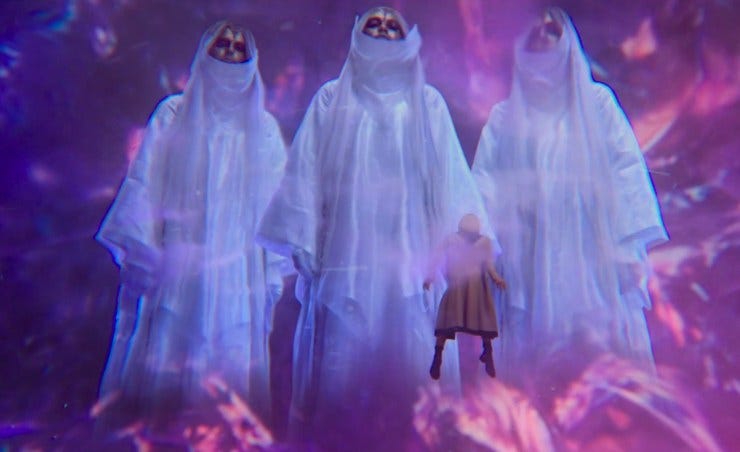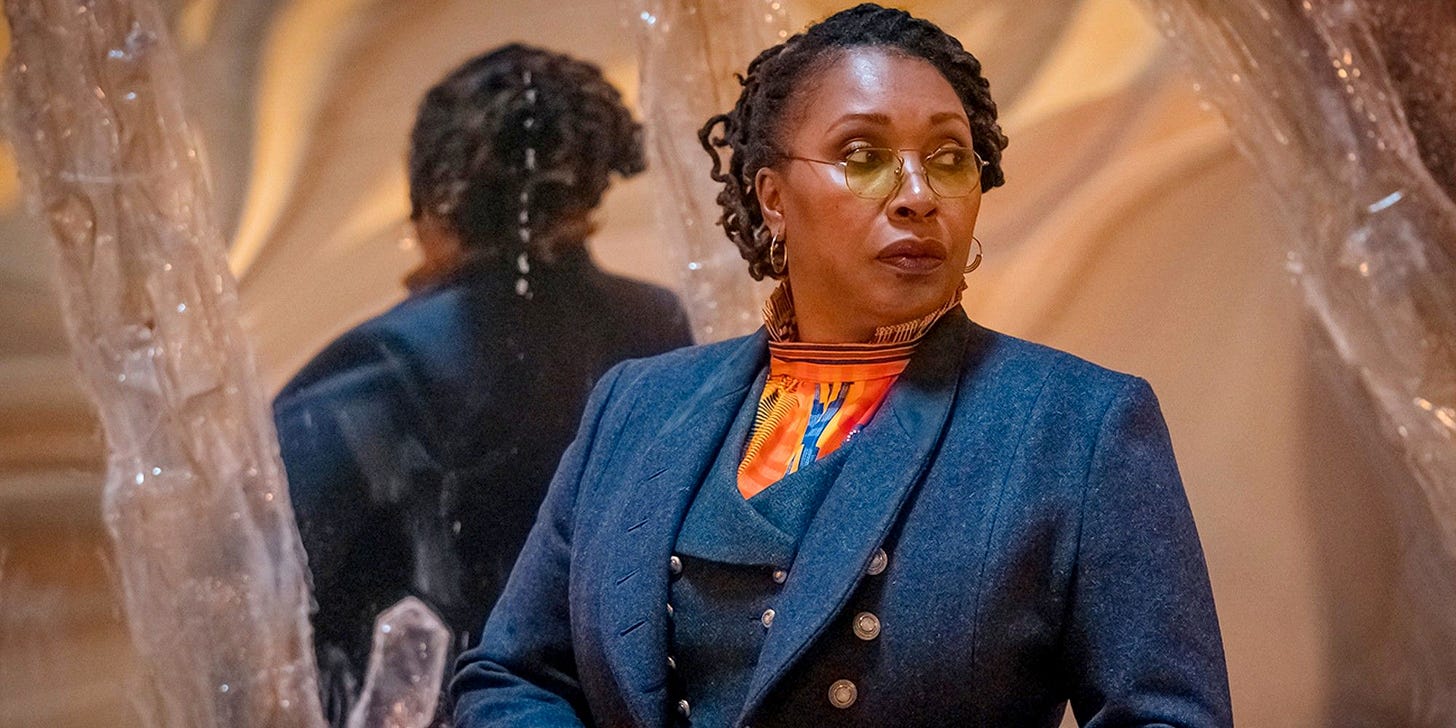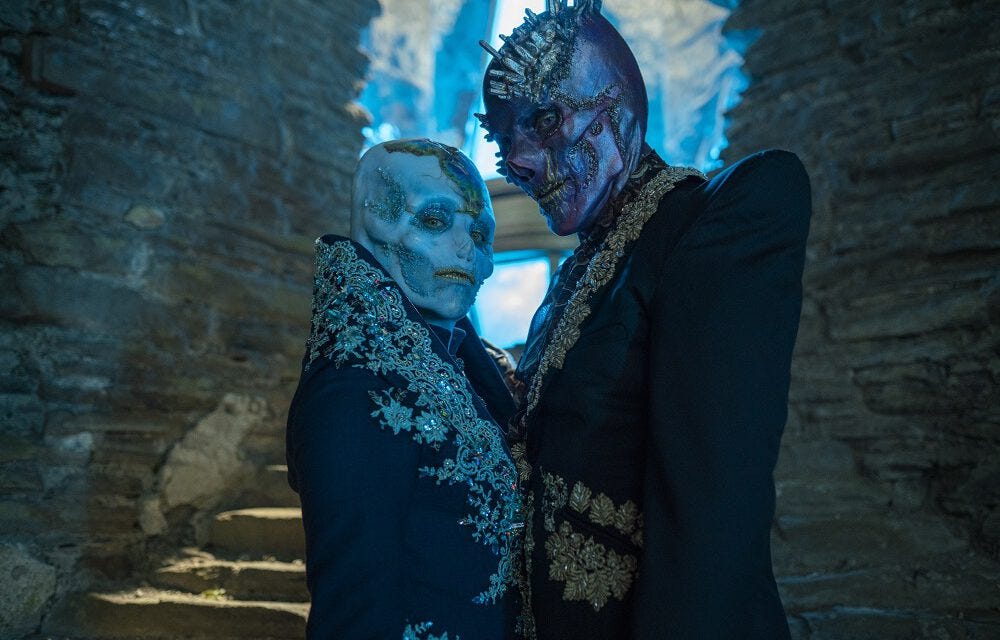“Chapter Three: Once, Upon Time”
Series 13, Episode 3
Written by Chris Chibnall
Directed by Azhur Saleem
Starring Jodie Whittaker, Mandip Gill, and John Bishop
Guest Starring Nadia Albina, Jacob Anderson, Craige Els, Thaddea Graham, Jo Martin, Craig Parkinson, Bhavnisha Parmar, Rochenda Sandall, and Sam Spruell
50 minutes
Original broadcast 14 November 2021
1. Time to Go
Doctor Who: Flux arrives at its midpoint, the third of six chapters, brimming with vim and vigor. In “Once, Upon Time,” showrunner Chris Chibnall’s talent for titles does him credit in an episode that takes the baton from its excellent predecessor, “War of the Sontarans,” and runs its leg of the race nearly as nimbly as I hoped it would.
Whereas Chapter Two concentrated on characterization, Chapter Three delves pell-mell into the timey-wimey shenanigans that the Flux event has promised from its first appearance (in Chapter One, “The Halloween Apocalypse”). “Once, Upon Time,” however, doesn’t abandon its characters to the arid plot mechanics that “The Halloween Apocalypse” foregrounded (perhaps inevitably, given its burden of setting up the premises, themes, and players that Chibnall weaves into Flux).
Instead, this third entry remains unafraid of splintering the Thirteenth Doctor’s (Jodie Whittaker’s) past, present, and future into a complicated story that loops around itself, moving backward and forward in time to reveal hidden secrets that make the Doctor’s mission—to save longtime companion Yasmin “Yaz” Khan (Mandip Gill), newfound companion Dan Lewis (John Bishop), and Observation Outpost Rose Officer Inston-Vee Vinder (Jacob Anderson) from the depredations of a timestorm unleashed by villainous siblings Azure (Rochenda Sandall) and Swarm (Sam Spruell)—almost too much to handle.
Almost, but not quite.
That both the Doctor and “Once, Upon Time” perform as well as they do is unsurprising given that Flux has three installments to go, but Chibnall takes the opportunity to show (finally) one of the missions that the Fugitive Doctor (Jo Martin)—the Thirteenth Doctor’s predecessor/successor/alternate-self—undertook while a member of Division, the temporal black-ops agency so secret that most Gallifreyans had no knowledge of its existence and so powerful that it erased the Doctor’s memory of being the Timeless Child.
Yet Chibnall doesn’t begin here. He instead introduces a brand-new character, Bel (Thaddea Graham), who narrates a letter to the father of her unborn child while dodging a Dalek patrol on an unnamed planet disrupted by the Flux event. The Daleks are conquering whatever they can in the Flux’s destructive wake (as the Sontarans tried in Chapter Two), prompting Bel to escape in an abandoned Lupari vessel and head toward her lover’s location. She tells him that the Lupari have disappeared from their home galaxy and then wonders if they have been annihilated from time in a grace note that makes Flux’s ongoing narrative seem vital and alive, for Bel has no idea that the Lupari journeyed to Earth to save humanity in “The Halloween Apocalypse.”
And why would she? Her concerns are personal despite the Flux’s cosmic implications, making Bel’s survival tale not merely a framing device, but one that Chibnall intersperses throughout “Once, Upon Time’s” packed narrative to anchor viewers in the Flux’s consequences for everyday people.
This move not only threatens to overcomplicate an already-complex storyline but also risks diverting attention from our principal cast, especially Dan (introduced only two episodes ago) and Yaz (who found herself at the center of these events as “War of the Sontarans” concluded). Chibnall, during Series 11 and 12, was criticized for shunting Yaz to the side, instead relying upon Mandip Gill’s brilliance at spinning gold out of the meager straw she sometimes received as a weak substitute for the attention Chibnall paid to the Doctor’s male companions, Ryan Sinclair (Tosin Cole) and Graham O’Brien (Bradley Walsh), who were, by comparison, richer personalities.
And if “Once, Upon Time” has a flaw, Yaz’s role is it. The minutes spent telling Bel’s story, no matter how attractive they may be, could (and should) have been devoted to Yaz. Chibnall’s choice is even more unfortunate considering that “Once, Upon Time” reveals—to no one’s surprise—that Bel writes her letter to Vinder, who finds himself inside the Temple of Atropos alongside Yaz during “War on the Sontarans,” where they’re both captured by Azure and Swarm, then forced to take the place of two murdered Mouri.
Yaz, as such, becomes second fiddle to a guest character played so nicely by Jacob Anderson that, like Sara Powell’s Mary Seacole in “War of the Sontarans,” he feels like an old friend only three installments into Flux’s six-segment run. Chibnall’s good taste in casting these roles, however, should not rely upon the performer’s talent and commitment to the part to overcome thin character writing. Crowding the field with Bel and Vinder’s backstories, while welcome from the perspective of narrative complexity, once again diminishes Yaz’s contributions to what is almost certainly her final season as a New Who companion.

2. Time to Show
“Once, Upon Time” is, therefore, not as well-oiled a storytelling machine as “War of the Sontarans,” but still better-balanced than “The Halloween Apocalypse.” I underscore these flaws at the beginning because, for most of its 50 minutes, “Once, Upon Time” is a gripping and fascinating race through the temporal mazes that typify the best time-travel stories.
Russell T. Davies and Steven Moffat excelled at such episodes (Moffat, indeed, preferred intricate, season-long story arcs that some fans, to this day, cannot parse), so Chibnall, as he approaches the climax of the Timeless Child mythology that will forever define both the Thirteenth Doctor’s character and Chibnall’s era of the franchise, demonstrates that he remains capable of constructing long-term mysteries that, one hopes, he can convincingly fulfill. Chibnall’s work on Dick Wolf’s Law & Order: UK and his own crime-thriller sensation Broadchurch (along with its American adaptation, Gracepoint) proves that he can write byzantine plots, but maintaining this high-wire narrative act over three seasons of Doctor Who puts even greater demands on him to deliver a tight and satisfying conclusion.

That some fans dislike Chibnall’s choice to rewrite the Doctor’s personal history is no surprise, but “Once, Upon Time” reveals how the stakes for Flux’s entire storyline were laid in the distant past, when the Fugitive Doctor—played once again by the fabulous Jo Martin, who blazes back onto the screen in Flux’s most-welcome return yet—led a team of three commandos (represented in flashback by Yaz, Dan, and Vinder dressed in combat attire) to break a siege at the Temple of Atropos and rescue the Mouri, who were held captive—then as now—by Azure and Swarm. Stopping the siblings in the present will, according to the Thirteenth Doctor, “reset time so the universe can function again” just as the Fugitive Doctor did when she conducted, all those years ago, a full military assault on the temple, complete with aerial bombardment, that saved the Mouri.
These scenes alternate with Doctor Thirteen floating inside the timestorm while speaking with three giant Mouri about how she wishes to save Yaz, Dan, and Vinder from certain death at the hands of Azure and Swarm even as flashes and snatches of the Fugitive Doctor’s mission bleed through (and sometimes overlay) these events. The storm, indeed, results from the Thirteenth Doctor intervening at the last possible second before Swarm snaps his fingers and unleashes time (or, more properly, Time, which becomes an almost-living character in this episode) upon Yaz, Dan, and Vinder, thereby ferrying them among past, present, and future memories of their own lives with little control (or hope) of escape.
The Mouri are physiologically capable of withstanding and regulating Time’s enormous force, but Yaz, Dan, and Vinder are not, making Azure’s and Swarm’s plan a replay of the hostage drama that the Fugitive Doctor—at Division’s behest—ended during the first Siege of Atropos. Her intervention led to the siblings’ millennia-long imprisonment, making Flux the greatest grudge match in New Who history.
This synopsis shows how tangled “Once, Upon Time’s” plot is, yet attentive viewers have no problem tracking its many subplots, flashbacks, and flashforwards, including one in which we learn how Vinder came to be exiled to Observation Outpost Rose—a drama in which Yaz plays the role of Vinder’s commanding officer—after he (Vinder) reports misdeeds by an intergalactic business tycoon named the Grand Serpent (Craig Parkinson), principally the Serpent’s plan to murder the family of a rival magnate, to higher authorities. Vinder’s whistleblowing act results in retribution that gets him banished to the most-remote location possible.
Yaz, by contrast, finds herself enjoying video games with her sister Sonya Khan (Bhavnisha Parmar) inside a room and a memory that Yaz doesn’t recognize, causing the Doctor (who pops up within each character’s memory play as a hologram that offers advice) to realize that Yaz’s timestream has gone wrong. This diagnosis proves spot-on when a Weeping Angel confronts Yaz, who only evades its attack by the narrowest of margins and, in the process, realizes that fabricated remembrances can sometimes prove more dangerous than actual ones.
Chibnall loads the deck with so many events, characters, stories, side stories, flashbacks within flashbacks, flashforwards within flashforwards, and memories of Thirteen’s life as the Fugitive Doctor that he threatens to capsize “Once, Upon Time” into an ocean of nonsense. Yet this outing admirably steers safely between its narrative rocks and shoals to reveal the origin of both Flux and the Flux event to be Azure’s and Swarm’s revenge quest. They abhor having been stopped from destroying the Mouri eons ago and then imprisoned by Division, where, as seen in “The Halloween Apocalypse,” Azure was forced to adopt a human guise as the Arctic researcher Anna and Swarm was locked into a containment facility on the Burnished Rage battleground.

3. Time to Tell
Flux’s basic story—if the term basic makes any sense when applied to a serial that piles up details the way Orson Welles stacked up food platters during his daily binges—is that Division’s greatest secret is the existence of the Temple of Atropos, housing as it does the Mouri, who control Time itself (meaning that they keep Time from haphazardly mixing and mashing events like those that the Thirteenth Doctor and her companions endure in “Once, Upon Time”). Azure and Swarm (known as “the Ravagers” to the Division agents assigned to deal with them) consider the Mouri to be blasphemous impositions upon Time who misguidedly attempt to bind this living force to rules that restrict its true nature.
This disagreement—over nothing less than the fundamental composition of creation itself!—precipitates what Swarm calls the Ravagers’ “founding conflict” with the Time Lords, namely a battle between Space and Time, with the Ravagers on the side of Time and the Time Lords—despite their name—on the side of Space. Since the Fugitive Doctor led the assault that defeated the Ravagers’ plan, Swarm considers himself the Thirteenth Doctor’s first archenemy. That she cannot remember this battle (because Division wiped her memories of the Fugitive Doctor and the Timeless Child) tips Flux into bottomless irony.
Or something like that.
As many Whovians have noted, Division resembles Classic Who’s Celestial Intervention Agency, a secret cabal with similar motives first mentioned in the 1976 Fourth Doctor (Tom Baker) serial The Deadly Assassin that’s appeared in ancillary novels, short stories, and audio dramas since the 1980s. The notion of a covert-operations bureau doing dirty deeds for supposedly enlightened future societies is nothing new (Star Trek’s Section 31 is perhaps the best iteration of this storyline, while the Marvel series Loki’s Time Variance Authority rips off Doctor Who wholesale), but Chibnall suggests in “Once, Upon Time” that Division may be an earlier version of the Celestial Intervention Agency, or perhaps the same agency under a different name, in his attempt to knit the reams and piles and warehouses of Who’s endless backstories into his Timeless Child tapestry.
Unlike some viewers, I admire Chibnall’s ambition in tackling so many of the franchise’s contradictory plot threads even if, after 58 years, weaving them into a comprehensive continuity is probably impossible. Still, good on Chibnall for giving it far more than the old college try! “Once, Upon Time” is paced like a thriller, shotgunning its audience through so many subplots, timelines, and vignettes that this outing should be, but isn’t, tough to understand.
Dan, for instance, finds himself back in 2021 Liverpool, popping up in different spots around the city at different times of the day and night (that shift without warning) while talking to Diane (Nadia Albina), the Museum of Liverpool employee whom he asked to dinner in “The Halloween Apocalypse” but who’s taken captive by Azure at that episode’s conclusion. John Bishop proves how welcome an addition he is by playing Dan’s continuing befuddlement and essential goodness with the same easy charm he did in his two previous appearances, even as he strikes a precise military bearing during his scenes as a Division agent. If Dan and Yaz received more attention here, “Once, Upon Time” would be an even better episode, so let us hope that Chibnall focuses on these core characters’ lives as Flux enters its final stretch.
This criticism doesn’t apply to the Doctor, who finds herself (as Thirteen or as the Fugitive Doctor) at the center of all events in “Once, Upon Time,” whether floating in the air while conversing with the Mouri or standing in the Temple of Atropos when confronting Swarm. Jodie Whittaker and Jo Martin are tremendous together and separate, but Whittaker shoulders this installment’s acting burdens by playing her scenes with the same guile, wit, and wonder she always has. The timestorm that the Doctor inadvertently creates when she tries to save Yaz, Dan, and Vinder from the Ravagers’ plan suggests that the entire episode takes place in the brief span needed for Swarm to snap his fingers, meaning that “Once, Upon Time” is an even wilier title than it first seems.
One final detail to appreciate is that Chibnall names the temple after the Greek mythological figure of Atropos, one of the three Sister Fates (collectively known, in yet one more connection, as the Moirai), indeed the Sister known as “the Inflexible One” who ended the existences of all mortal beings by cutting the threads that represent their lives. This point makes the Doctor’s journey in “Once, Upon Time” more than just an energetic jaunt through her uncertain memories by sounding an important theme, namely that history itself is a narrative construction susceptible to revision, not the immovable sequence of events we might assume it to be.
This perspective provides crucial food for thought in our reactionary political times, where arguments over the “proper” telling of history have become desultory shoutfests in which proponents of traditional (and therefore incomplete) understandings of the past try their worst to discredit any retelling that questions their power and authority. New Who has always maintained that time can be rewritten, but “Once, Upon Time” takes this precept to heart to fashion an episode that encourages us to keep our eyes and our minds open.
Not bad for 50 minutes of television, I say, so—despite “Once, Upon Time’s” imperfections—Chris Chibnall, his cast, and his crew once again have my thanks.





